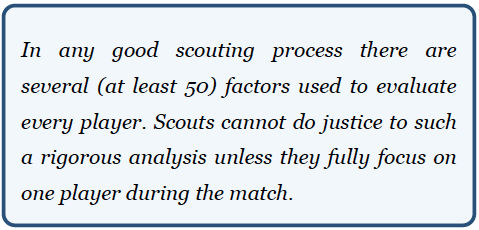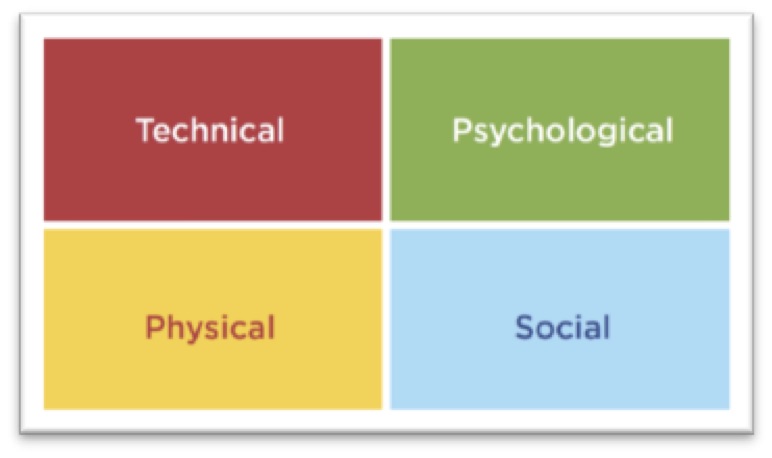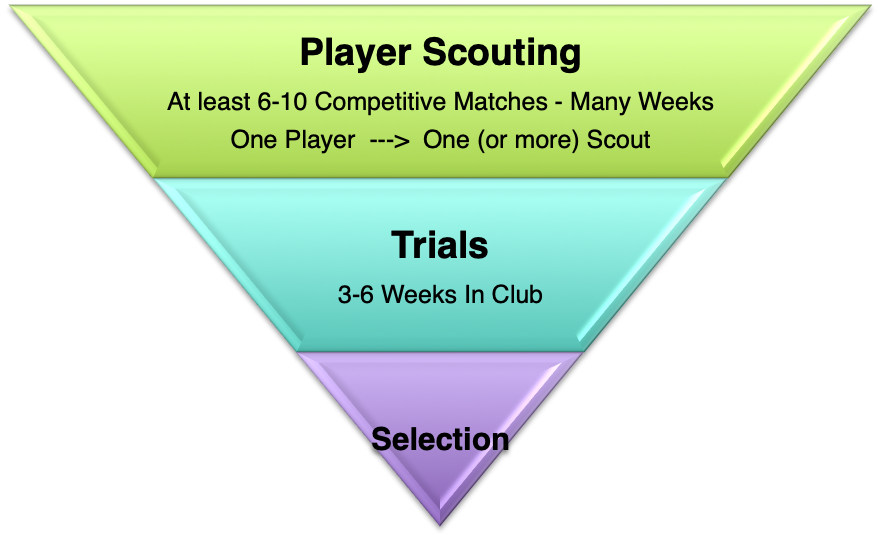Myth: Football potential is judged through skills and physique.
Fact: Many more criteria determine true potential.
Imagine two students in the 8th grade of school. Student A is asked to study eight subjects and then is tested in only one subject – chosen randomly. Student B is given the test subject and the relative weight of sections within that subject in advance. Naturally, all other things being equal, Student B will be able to prepare better and very likely outperform Student A.
Obviously, if one knows the criteria for evaluation, the preparation can be more productive.
Most young players and parents are like Student A in Football selections. They don’t usually know the criteria on which long-term potential is judged. This is true in many countries – even those that are fairly advanced in the game. Unfortunately, in countries like India, a majority of football academies and selectors are as ignorant as the players and parents.
The result: many young players get wrong feedback and opt out of the sport even if they may have higher long-term potential to succeed.

In this article we explore the following:

Criteria To Judge True Long-Term Potential
A popular myth is that skills and physique determine the potential of young footballers.
Not true!
The top football academies in the world use a combination of skills, physique, game intelligence and attitude to select their recruits.
Skills and physical ability are obvious criteria that show how a player can play at that point in time. And there are various position-specific parameters to judge the optimum skill and physical ability at any given age. Both skill and physique can be developed over time with the right training that is game specific.
Since young players have different rates of physical development, the position they play in need not be the one they have eventually. So young players are usually assessed on broader parameters of skill and physique, with some room for flexibility based on their physical growth, compared to senior players.
Game intelligence is what a player should be doing in any given situation of the game. It is a very important criterion in many advanced countries of youth football like Germany and Spain. Studies prove that an average professional player has the ball for about 1 minute out of 90 minutes during the game. Obviously, the player’s actions for the remaining 89 minutes are as important (if not more) as the skills with the ball. Effective movements are based on game intelligence – awareness of the present situation and the possibilities that can come up. The best way to develop it is by playing matches and rigorous analysis.
Attitude determines whether the players fulfill their potential or not. It comprises of psychological and sociological factors like discipline, commitment, and teamwork that impact the long-term development of a player. Attitude plays a huge role in player development – the transition from youth to professional football.
Is There A Universally Accepted Formula?
Each academy uses a combination of the above criteria to select youth players using a metric that fits their own playing style – usually directed by the first team coach and implemented by the coaches of various age groups.
There is no universal standard “method” to determine the football potential.

English FA 4-corner model for Talent Identification
Moreover, age plays an important role in choosing the right balance between the above factors. An 8-year-old player is judged differently to a 10-year-old and so on.
There are also wide differences in the selection of players based on the football environment where the player grew up. For instance, a player in Portugal might typically play between 80-100 competitive matches per year from a young age while a player in India probably plays those many matches in 8-10 years. Also, the Portuguese players benefit from a lot of pre and post-match analysis while young Indian players hardly have any in comparison. So it is unreasonable to expect Indian players to have the same level of Game Intelligence.
How Are Young Players Selected In Europe?

Scouting is over a prolonged period of time to judge consistent player performance in competitive matches over several weeks. Not one-off trial or non-competitive matches or practice sessions. Multiple scouts may be involved in each player selection, particularly in higher age groups and bigger clubs.
Each scout observes only one player during the entire match. They follow every action of the player and don’t pay attention to other players or movements not related to that player.
Each player is evaluated on several parameters. For example, in any good scouting process, there are at least 50 parameters used to evaluate each player. Scouts cannot do justice to such a rigorous analysis unless they only focus on one player.
Although video analytics has made huge strides in professional football, scouting is still people driven. There are many aspects that can’t be captured on video. So successful clubs tend to have a lot of scouts.
Clubs invite the scouted players for further trials with their team. Most academy trials (and even professional player trials) happen over a few weeks, not a day or two (unlike India). Some or all the above criteria are analyzed again in the trial period. The selected players are offered a club registration contract.
These contracts are of one-year duration typically and each player is meticulously evaluated over this time. Those who don’t meet the expectations of the club are not retained and new players are signed.
This process is quite expensive but worth the costs since the objective is to find the best long-termprospects who can turn professional.
Case Study – Football Academies In England
Football academies in England observe players over a considerable period of time and then conduct multi-week trials for the scouted players. Selected players are offered registration contracts. U9-U15 players sign annual contracts. Some U13-U15 players also get two-year contracts. Professional contracts are offered from the age of 16.

If any player wants to join another academy then the player’s existing club should get training compensation from the new club. This compensation is determined by English FA based on its classification of the academies into categories. A majority of such transfer compensations are waived off (over 90% in 2017) but the clubs tend to insist in certain cases – usually the more promising players or ones who have personal issues with the club staff. In such cases, depending on the registration contract the player has signed(YD10 forms being more restrictive), the new club has to pay the releasing club based on the formula shown above.
This compensation is FIFA guided and is an effort to motivate youth development among clubs.
Unfortunately, it is not implemented in some countries like India yet. So there is no financial incentive for academies to develop players.
How Are Young Players Selected In India?

Selection to most football academies in India is usually through one-off trials. Players go through pre-determined skill tests and/or play matches with other participants.
Long-term potential can’t be reliably identified through such trials for many reasons:
- It is based on a stimulated environment – far from ideal – and not competitive matches.
- Certain players may not perform on the day/s due to various reasons – injury, unfamiliar playing conditions, unfamiliar teammates, unfamiliar training drills, and so on.
- No consideration for outlier performances: good or bad – that can’t be consistently repeated.
- Only skills and physique can be judged in such a process. Not game intelligence (since teammates are unfamiliar with each other) or attitude.
- Too few selectors for too many players. In-depth assessment of each player is impossible.
These selections are not reliable. Players who are not selected also get demotivated.
Such trials are common in India due to lack of enough youth matches, logistical convenience and cost considerations. Moreover, professional scouting knowledge and experience is almost non-existent. Most selectors are ignorant of basic scouting principles. Any ex-player or coach is not necessarily a good scout unless he/she is trained in scouting. But these are the typical selectors in India as hardly anybody is properly trained in scouting.
The process is deeply flawed and not appropriate for identifying long-term potential. It is at best suitable to determine which players can perform better at that particular point of time.
How Does This Impact YOUR Child?
Clubs in Europe are economic entities and won’t have a lengthy process if they can avoid the costs. But there is no substitute for the intensive scouting process that is equally reliable – whether video recordings or short duration trials.
In countries like India, the selection process is generally flawed as it relies heavily on one-off trials. So if your child is not selected to any particular team through such a process, don’t take it as a conclusive verdict on the long-term football potential of your child.
Your child needs to go through a more rigorous assessment process for you to understand the best way forward.
Key Takeaways
- Football potential is much more than only evaluating skills and physique.
- Short-term trials are not the right way to evaluate the true potential of footballers.
- Proper talent identification needs a scientific process with several parameters.
References:
- Calvin, Michael (2o14). The Nowhere Men. London: Arrow Books
- https://www.ndr.de/fernsehen/sendungen/sportclub/Sportclub-Story-Fussballscouts-auf-Spielersuche,sportclub8302.html
- https://thepfsa.co.uk/
- http://www.telegraph.co.uk/football/2016/12/21/youth-players-left-scrapheap-thanks-exorbitant-compensation/
- http://www.bbc.co.uk/sport/football/41839083

i want to enroll my child in football. any suggestion for enrollment in guwahati, assam, india.He crossed his two years mark on december 2018.
Thank you for reaching out Naushad. At this age, the emphasis should be on having fun while playing rather than structured coaching. He is too young for regimented training right now. Street football without too much adult intervention and regimented rules would work best. The more fun he has, the more he will love the game and the more desire he will have to play in the future. At two years of age, children are not yet fully social and perhaps your child will enjoy playing with you or siblings even more than with strangers. Best wishes!
My son is in class 9 .Age 15 years . He wants to develop into a professional footballer.
Good to know about your son's ambition Sondeep. Best Wishes!